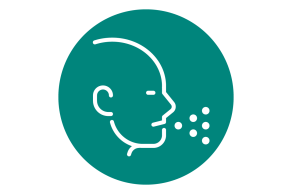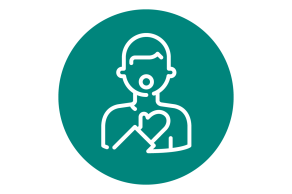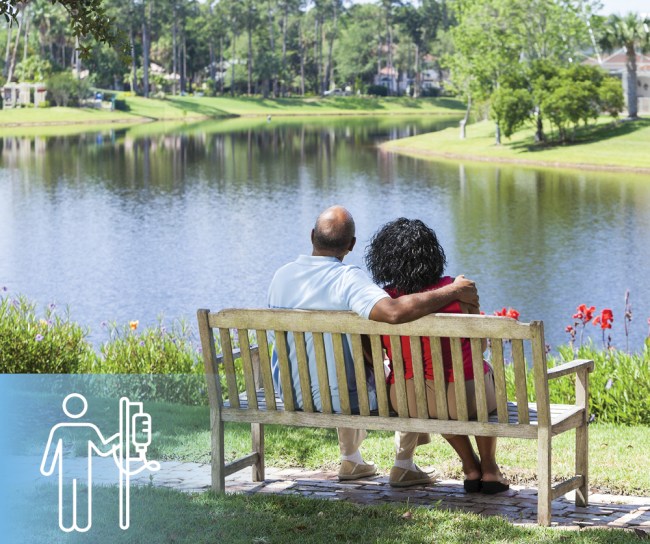
TYPES OF NSCLC 1

ADENOCARCINOMA
This type of lung cancer starts in cells that ordinarily secrete substances like mucus. It is usually located in the outer regions of the lungs.1
While this form of cancer occurs most commonly in people who smoke or are former smokers, it is also the most common form of lung cancer occurring in non-smokers. It occurs more frequently in younger people than the other lung cancers and is also more common in women than in men.1
This form of cancer is often diagnosed prior to it spreading to other areas.1

SQUAMOUS CELL CARCINOMA
This form of NSCLC starts in the flat cells that line the inside of the airways of the lungs, which are called squamous cells.1
These carcinomas tend to be found in the central part of the lungs, close to the bronchus.1
A history of smoking is often linked to this type of cancer.1

LARGE CELL (undifferentiated) CARCINOMA
A large cell carcinoma can be found in any part of the lung.1
It can be difficult to treat, as it tends to grow and spread quickly.1
The subtype of large cell carcinoma, known as large cell neuroendocrine carcinoma, spreads rapidly and bears some similarities to small cell lung cancer.1
RATE OF INCIDENCE
Cancer of the lungs is the most common cause of deaths related to cancer.2
SIGNS AND SYMPTOMS 3,4

Persistent cough
A cough that lingers or worsens

Coughing up blood
Cough with blood stained sputum

Pain
Pain or ache in the chest or shoulder

Fatigue
Feeling weak or tired

Lessening of appetite
A declining interest in eating

Weight loss
An unexplained loss of weight

Hoarseness
A weak, scratchy or husky voice

Wheezing
New onset of wheezing

Persistent chest infection
Bronchitis or pneumonia that recur

Shortness of breath
A feeling of breathlessness
RISK FACTORS 5,6
The risk factors include:
Smoking
This includes passive smoking or inhaling second-hand smoke

Air pollution
Exposure to ambient air pollution from motor vehicle exhaust, smoke from wood fires and fumes from asphalt roads

Alcohol
There is a slightly higher risk of lung cancer in people who consume alcohol.

Occupational exposure
Silica dust and asbestos fibers are well-known human carcinogens – workers exposed to these are at a higher risk

Genetic risk factors
There is strong evidence that lung cancer is hereditary

WAYS TO LOWER THE RISK 7,8

-
Avoid or stop smoking
-
Avoid radon exposure
-
Adopt a healthy diet
-
Avoid or limit exposure to agents that can cause cancer

Some of the known cancer-causing agents are: 8,9
Asbestos
Uranium
Arsenic
Cadmium & Chromium
Nickel
Petroleum products
Coal products
Diesel exhaust fumes
LOCAL TREATMENT OPTIONS FOR NSCLC

SURGERY
In the early stages surgery can be used as a possible means of treating patients with NSCLC. This offers the best chance of curing the illness.10,11
Surgery involves removing the tumour along with some of the tissue surrounding it. This is only an option for some patients, as factors such as their other medical conditions as well as the location and stage of the cancer would need to be considered. If the cancer is localised and has not spread, surgery is considered the best option.11

CHEMOTHERAPY
Chemotherapy involves using medicines to destroy cancer cells by preventing their growth, division and multiplication. This form of treatment has been shown to both prolong and improve the quality of life for patients with all stages of lung cancer.12

RADIATION THERAPY
Radiation therapy involves using high energy x-rays or other particles to destroy cancer cells. Widespread cancer cannot be treated using this form of therapy as the radiation beam can only affect the cancer cells that are directly in its path.12

TARGETED THERAPY
This method of treatment targets the cancer’s specific genetic components and proteins or the tissue environment that contributes to its growth and survival. Targeted therapy blocks the spread and growth of cancer cells and limits damage to healthy cells.12

IMMUNOTHERAPY
Immunotherapy boosts the patient’s natural defence system so that it can mount an attack against the cancer. It makes use of materials made by the human body itself or those made in a laboratory. The therapy acts on the immune system to restore or improve its functioning.12,13
SPEAK TO YOUR HEALTHCARE PROFESSIONAL
The information on this page is intended to offer an overview of NSCLC
IT IS IMPORTANT TO SPEAK TO A HEALTHCARE PROFESSIONAL FOR ADVICE ABOUT ANY SYMPTOMS OR SIGNS THAT CONCERN YOU
REFERENCES:
- American Cancer Society. What is lung Cancer? Updated January 2023. Available at: https://www.cancer.org/cancer/lung-cancer/about/what-is.html. Accessed: March 2023.
- Koegelenberg CFN, Dorfman S, Schewitz I, et al. Recommendations for lung cancer screening in Southern Africa. J Thorac Dis. 2019;11(9):3696-3703.
- American Cancer Society. Signs and Symptoms of Lung Cancer. Updated October 2019. Available at: https://www.cancer.org/cancer/lung-cancer/detection-diagnosis-staging/signs-symptoms.html. Accessed: March 2023.
- Cancer Research UK. Symptoms of lung cancer. Updated December 2022. Available at: https://www.cancerresearchuk.org/about-cancer/lung-cancer/symptoms. Accessed: March 2023.
- Molina JR, Yang P, Cassivi SD, et al. Non–Small Cell Lung Cancer: Epidemiology, Risk Factors, Treatment, and Survivorship. Mayo Clin Proc. 2008;83(5):584–594.
- CDC. National Biomonitoring Program. Polycyclic Aromatic Hydrocarbons (PAHs) Factsheet. Available at: https://www.cdc.gov/biomonitoring/PAHs_FactSheet.html. Accessed: March 2023.
- American Cancer Society. Can Lung Cancer be Prevented? Updated October 2019. Available at: https://www.cancer.org/cancer/lung-cancer/causes-risks-prevention/prevention.html. Accessed: March 2023.
- American Lung Association. Lung Cancer Causes & Risk Factors. Updated November 2022. Available at: https://www.lung.org/lung-health-diseases/lung-disease-lookup/lung-cancer/basics/what-causes-lung-cancer. Accessed: March 2023.
- American Cancer Society. Lung Cancer Risk Factors. Updated January 2023. Available at: https://www.cancer.org/cancer/lung-cancer/causes-risks-prevention/risk-factors.html. Accessed: March 2023.
- American Cancer Society. Treatment Choices for Non-Small Cell Lung Cancer, by Stage. Last revised January 2023. https://www.cancer.org/cancer/lung-cancer/treating-non-small-cell/by-stage.html. Accessed: March 2023.
- American Lung Association. Lung Cancer Surgery. Updated November 2022. https://www.lung.org/lung-health-diseases/lung-disease-lookup/lung-cancer/treatment/types-of-treatment/lung-cancer-surgery. Accessed: March 2023.
- Cancer.net. Lung Cancer – Non-Small Cell: Types of Treatment. December 2022. Available at: https://www.cancer.net/cancer-types/lung-cancer-non-small-cell/types-treatment. Accessed: March 2023.
- Cancer.net. American Society of Clinical Oncology (ASCO). ASCO answers. Understanding lmmunotherapy. Available at: https://www.cancer.net/sites/cancer.net/files/asco_answers_immunotherapy.pdf. Accessed: March 2023.
ZA-KEY-00670 03/25
